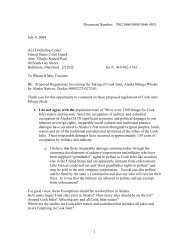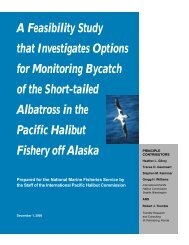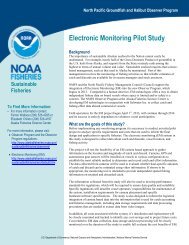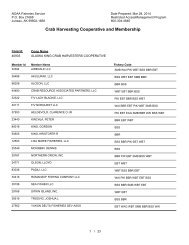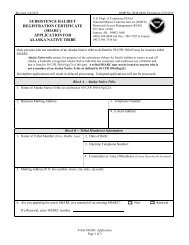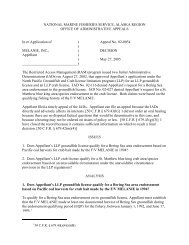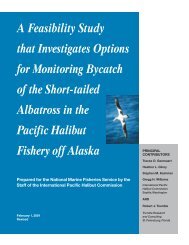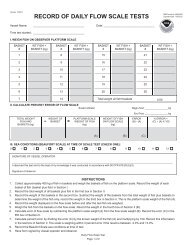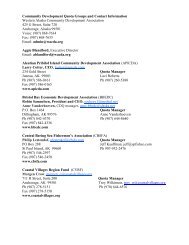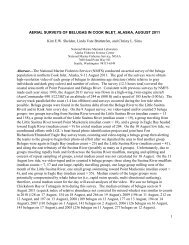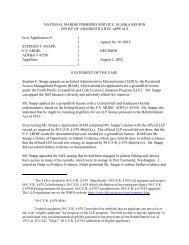Petition to List Lynn Canal Pacific Herring under the Endangered ...
Petition to List Lynn Canal Pacific Herring under the Endangered ...
Petition to List Lynn Canal Pacific Herring under the Endangered ...
Create successful ePaper yourself
Turn your PDF publications into a flip-book with our unique Google optimized e-Paper software.
demonstration of monophyly, which are criticisms leveled at various versions of<br />
<strong>the</strong> [Evolutionary Significant Unit] as well. The discovery of real evolutionary<br />
and his<strong>to</strong>rical entities is <strong>the</strong> precinct of systematics, which clearly has a vital role<br />
<strong>to</strong> play in identifying those entities (Dimmick et al. 1999; Mace 2004).<br />
Contrarily, conservation status is determined based on ecological data, including<br />
information on habitat and population trends and threats, according <strong>to</strong> criteria<br />
grounded, for instance, in time-<strong>to</strong>-extinction models (Mace & Lande 1991;<br />
Gardenfors 2001). Employment of [Designatable Units] is a pragmatic approach<br />
<strong>to</strong> extinction risk assessment that seeks <strong>to</strong> avoid serious conceptual and<br />
methodological pitfalls of approaches based <strong>to</strong>o exclusively on taxonomic<br />
inference.<br />
Scientists are rightfully prudent <strong>to</strong> avoid adding false information <strong>to</strong> <strong>the</strong> canon of<br />
knowledge. They <strong>the</strong>refore scrupulously avoid <strong>the</strong> possibility that <strong>the</strong>y might<br />
accept a hypo<strong>the</strong>sis that is actually false. If we as scientists are <strong>to</strong> be wrong, we<br />
consider it better <strong>to</strong> reject a hypo<strong>the</strong>sis even though it may be true. In science this<br />
is a sensible and precautionary policy (Taylor & Dizon 1999). But recognizing<br />
and listing endangered species is not science. It is an aspect of environmental and<br />
conservation policy that is best guided by <strong>the</strong> results of science. The ultimate<br />
consequence of failing <strong>to</strong> safeguard a species that is actually endangered (i.e., <strong>the</strong><br />
error of rejecting a hypo<strong>the</strong>sis of endangerment even though it may be true) is dire<br />
and irreversible. In conservation practice, unlike <strong>the</strong> practice of science, we must<br />
avoid that sort of error and be careful not <strong>to</strong> lose potentially unrecognized species<br />
from <strong>the</strong> canon of life.<br />
(Green et al. 2005). Under this view, genetic uniqueness is important in discerning what<br />
populations of a species should receive protection, but genetics is not <strong>the</strong> only<br />
consideration. Ultimately, <strong>the</strong> “occupation of differing biogeographic regions by a<br />
species” is most important when defining what populations are need of protection.<br />
39



